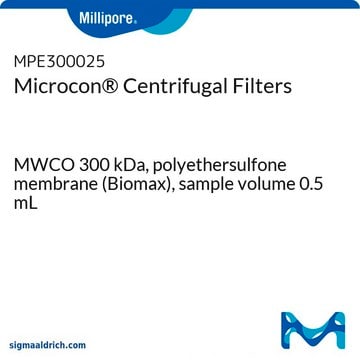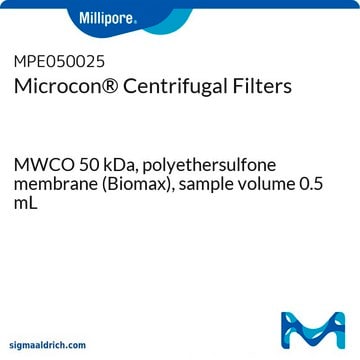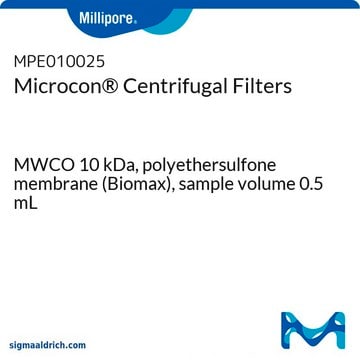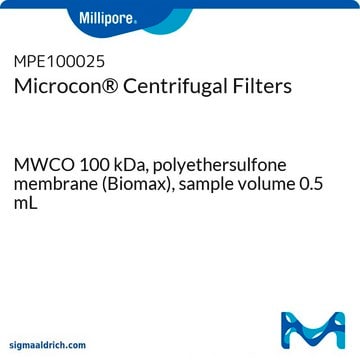Yes, a Microcon DNA fast flow device can be used to isolate DNA from a crude cell lysis preparation. However, lysates typically contain heavy particulate contamination, so clarification spins may be necessary to remove particulates before attempting ultrafiltration.
MRCF0R100
Filtros de centrífuga de flujo rápido de ADN Microcon®
sample volume 0.5 mL, Ultracel® regenerated cellulose membrane (low binding)
Sinónimos:
Centrifuge concentrator
Seleccione un Tamaño
Seleccione un Tamaño
About This Item
Productos recomendados
Materiales
Ultracel® regenerated cellulose membrane (low binding)
polyacetal base (membrane support)
polycarbonate device top
polypropylene tube (for filtrate/concentrate)
silicone O-ring (medical-grade)
Nivel de calidad
esterilidad
non-sterile
Características
holdup volume> 10 μL
envase
pkg of 100 ea
fabricante / nombre comercial
Microcon®
Parámetros
0.5 mL sample volume
técnicas
DNA purification: suitable
RNA purification: suitable
Longitud
4.50 cm (1.8 in.)
Diámetro
12.3 mm
filtración área
0.32 cm2
volumen de trabajo
0.5 mL
Condiciones de envío
ambient
Categorías relacionadas
Descripción general
Aplicación
Características y beneficios
- gran recuperación de volúmenes pequeños con espín inverso
- membrana Ultracel® de baja adsorción
- procesamiento rápido
- factores de concentración de rendimiento <X20 para una reproducibilidad uniforme
Ligadura / enlace
Información legal
Certificados de análisis (COA)
Busque Certificados de análisis (COA) introduciendo el número de lote del producto. Los números de lote se encuentran en la etiqueta del producto después de las palabras «Lot» o «Batch»
¿Ya tiene este producto?
Encuentre la documentación para los productos que ha comprado recientemente en la Biblioteca de documentos.
Contenido relacionado
Microcon® Centrifugal Filters simply and efficiently concentrate and desalt solutions of DNA, RNA, protein or other macromolecules, using any centrifuge that can accept 1.5 mL tubes.
-
Can I use a Microcon DNA fast flow device to isolate DNA from a crude cell lysis preparation such a freeze thaw in TE buffer or a chelex 100 extraction?
1 answer-
Helpful?
-
-
The user guide indicates you can't autoclave these microcon, but can you sterilize them in a UV Crosslinker?
1 answer-
The Microcon devices are non-sterile. These devices cannot be sterilized by UV or autoclaving. However, it is possible to sanitize the devices with 70% ethanol. Please see the protocol for sanitization below:
1. Reagent Preparation: 70% Ethanol solution (v/v) is prepared by dilution in distilled water. Both the ethanol solution and distilled water used for rinsing should be filter-sterilized using sterile, 0.22 µm sterilizing grade filter device.
2.Sanitization Protocol:
A. Fill the Microcon device to its published capacity with filter-sterilized 70% ethanol, and cap the unit (note that the collection tubes can be sanitized in the same manner).
B. Invert device by hand or in an end-over-end mixer to continuously wet all internal surfaces of the device.
C. Incubate for a minimum of 5 minutes (note that the device can be capped and left for up to 24 hours if it is not going to be used immediately).
D. Spin at recommended G-force using appropriate centrifuge until at least 50% of the volume has passed through the device.
E. Aseptically discard any remaining ethanol from the filter device and filter collection tube.
F. Immediately rinse away residual ethanol by adding the filter-sterilized water to the device's published capacity, mix gently to wet all areas, and centrifuge until at least 50% of the volume has passed through the device.
G. Discard any remaining liquid from both the concentrator device and filter collection tube before use.
DO NOT let the filter membrane dry out in concentrator unit. If the devices are not to be used immediately, fill the devices with filter-sterilized distilled water, cover, and store refrigerated. Remove liquid from device as previously described prior to use.
Helpful?
-
-
Has the color of the Microcon DNA Fast Flow become brighter blue?
1 answer-
Yes, the color of the device has changed. A new blue colorant and clear resin have replaced the original blue reservoir resin, which has been discontinued. Both old and new resin are HP2 Polycarbonate. The functionality of the product has not changed.
Helpful?
-
Active Filters
Nuestro equipo de científicos tiene experiencia en todas las áreas de investigación: Ciencias de la vida, Ciencia de los materiales, Síntesis química, Cromatografía, Analítica y muchas otras.
Póngase en contacto con el Servicio técnico





